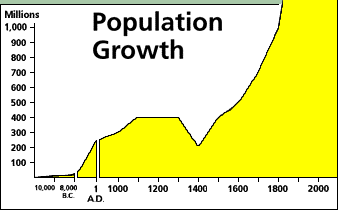| |
Why do we need DL?
|
What thoughts first come to mind when someone says
the words, "school", "university"
or "education". Do you conjure up visions
of buildings, auditoriums, classrooms, labs, and numerous
students milling about? If you were asked to "word
associate" the same terms with regard to your future
vision of education in ten or fifteen years, would your
answers differ significantly? Probably not… but
a number of societal demands and emerging technologies
are converging to change the future delivery of education.
In fact, the seeds of change for twenty-first-century
education were sown in the years after World War II
and have been germinating slowly for fifty years.
The first blooms of the diverse educational landscape
of the future are just beginning to be seen.
(Cyrs, 1997: 7)
Demands - Population Growth and Technology
The additional demands on education are numerous.
World population is soaring at an exponential rate.
The human population will double by the middle of the
next century (Erlich, 1997). Rising school enrollments
could cripple our nation's education system. Technology,
too, is expanding at an ever burgeoning pace. As the
world, and developed nations in particular, shift from
the industrial to the technological revolution, new
educational delivery systems must be developed and implemented
to keep pace with the increasing number of education
consumers and the onslaught of technological innovations.
Imagine the need for an educated and trained work force
in a world with an additional 5 billion people…
in less than 50 years!
The Learning Society
Unfortunately, the current system for educational
delivery (based on the existence of a campus, classroom,
and time constraints) has been in place for several
hundred years, and this model was greatly expanded after
World War II. The great expansion of public higher education
in the United States was a result of the baby boom of
the late '40's and '50's and the return of veterans
using the G.I. Bill. Hundreds of new educational facilities
were constructed or expanded by planners using the "campus
based" model of the time. The idea of life-long
learning was not considered. At the time, the majority
of students attending college were between the ages
of eighteen and twenty-one. The fact that sky-rocketing
technological growth would require the lifelong education
or retraining of an aging workforce, with ever decreasing
mortality rates, was not considered. The notion that
one individual might have two or three different "careers"
within their lifetime was not conceived. This concept
of lifelong education and an ever "learning society"
was first put forth by UNESCO's International Commission
on the Development of Education:
|
 |
|
"If all that has to be learned must be continually
re-invented and renewed, then teaching becomes education
and, more and more, learning. If learning involves all
of one's life, in the sense of both time-span and diversity,
and all of society, including its social and economic
as well as its educational resources, then we must go
even further than the necessary overhaul of 'educational
systems' until we reach the stage of a learning society."
(Evans, 1996: 174)
|

Figure 1. Graph from "Paul Erlich and The
Population Bomb." (Erlich, 1997) |
In industrialized countries, participation in education until
the age of 16 is now universally accepted and the participation
rate is at or approaching 100%. In addition, participation
in post-secondary education has seen a dramatic increase in
demand:
Sampling of participation in post-secondary
education
20 to 24 year old age group - by percentage
| Country |
Base Year - 1960
|
1996
|
| United States |
32%
|
60%
|
| Canada |
16%
|
55%
|
| France |
7%
|
30%
|
| Japan |
9%
|
29%
|
Table 2 . Data Source: Opening education / policies and
practices
from open and distance education. (Evans, 1996: 172)
Once again, the problem of increased demand combined with
increased population is evident. The infrastructure necessary
to accommodate the growing number of young and old education
consumers does not exist… and the pressure is on to find
innovative and cost-effective solutions. The alternative is
more restrictive access to education, essentially cutting
off a segment of the world's populous.
Why is there so much interest in distance education? There
are many reasons, both sociological and economic. First,
the rapidly growing world population is putting a greater
strain on educational resources and encouraging both individuals
and governments to find new methods of providing education
to greater numbers. That growing population is increasingly
mobile. People no longer accept the inevitability of following
the same path as their parents. They are interested in learning
new skills, new abilities, perhaps following a new career.
Long seen as available only to the elite, education is now
being demanded by more and more people. At the same time,
the economic situation of many people often makes it difficult
or impossible for them to attend a college or university.
Distance education comes more conveniently to them. (Mood,
1995: 141)
|